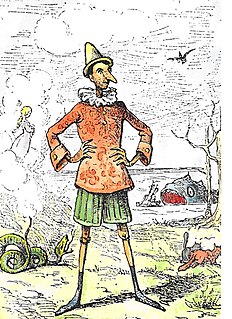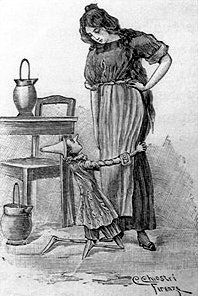
Animation is a method in which figures are manipulated to appear as moving images. In traditional animation, images are drawn or painted by hand on transparent celluloid sheets to be photographed and exhibited on film. Today, most animations are made with computer-generated imagery (CGI). Computer animation can be very detailed 3D animation, while 2D computer animation can be used for stylistic reasons, low bandwidth, or faster real-time renderings. Other common animation methods apply a stop motion technique to two- and three-dimensional objects like paper cutouts, puppets, or clay figures.

The Adventures of Pinocchio is a novel for children by Italian author Carlo Collodi, written in Pescia. It is about the mischievous adventures of an animated marionette named Pinocchio and his father, a poor woodcarver named Geppetto.

Pinocchio is a 1940 American animated musical fantasy film produced by Walt Disney Productions and based on the 1883 Italian children's novel The Adventures of Pinocchio by Carlo Collodi. It was the second animated feature film produced by Disney, made after the first animated success Snow White and the Seven Dwarfs (1937).

The Fairy with Turquoise Hair is a fictional character in the 1883 Italian book The Adventures of Pinocchio by Carlo Collodi, repeatedly appearing at critical moments in Pinocchio's wanderings to admonish the little wooden puppet to avoid bad or risky behavior.
While the history of animation began much earlier, this article is concerned with the development of the medium after the emergence of celluloid film in 1888, as produced for theatrical screenings, television and (non-interactive) home entertainment.
John Hubley was an American animation director, art director, producer and writer of traditional animation films known for both his formal experimentation and for his emotional realism which stemmed from his tendency to cast his own children as voice actors in his films.
Jiří Trnka was a Czech puppet-maker, illustrator, motion-picture animator and film director.

Mangiafuoco is a fictional character who appears in Carlo Collodi's 1883 book The Adventures of Pinocchio. He is the theatre director and puppet-master of the Great Marionette Theatre.

The Terrible Dogfish is a dogfish-like sea monster, which appears in Carlo Collodi's 1883 book The Adventures of Pinocchio. It is described as being larger than a five-story building, a kilometer long and sporting three rows of teeth in a mouth that can easily accommodate a train. So fearsome is its reputation, that in Chapter XXXIV, it is revealed that the Dogfish is nicknamed "The Attila of fish and fishermen".
Pinocchio is the boy-puppet from the 1883 novel The Adventures of Pinocchio by Italian author Carlo Collodi.

Pinocchio is an Italian fictional character and the protagonist of the children's novel The Adventures of Pinocchio (1883) by Italian writer Carlo Collodi of Florence, Tuscany. Pinocchio was carved by a woodcarver named Geppetto in a Tuscan village. He was created as a wooden puppet but he dreams of becoming a real boy. He is notably characterized for his frequent tendency to lie, which causes his nose to grow.

The Adventures of Pinocchio is a 1972 Italian animated film adaptation of Carlo Collodi's 1883 book The Adventures of Pinocchio. It was directed by Giuliano Cenci and produced by Cartoons Cinematografica Italiana. The English-dubbed version was released in the United States by G.G. Communications in 1978.

The Green Fisherman is a fictional character who appears in Carlo Collodi's book The Adventures of Pinocchio. He dwells in a sea cave on the coast of Busy Bee Island where he lives on a diet seemingly composed entirely of sea life. He is described as "...so ugly, he looked like a sea monster. Instead of hair, he had on his head a dense clump of green grass; green was the skin on his body, green were his eyes, green was his long beard which drooped downards. He looked like a great lizard erected on its hind legs."

The New Adventures of Pinocchio is a 1960-1961 syndicated stop motion animated television series produced by Rankin/Bass Productions in the United States and made by Dentsu Studios in Japan. Created by Arthur Rankin, Jr. and his partner Jules Bass, it was based on the 1883 book The Adventures of Pinocchio written by Italian author, Carlo Collodi. The series was Rankin/Bass' first production to be made in "Animagic", a stop motion puppet animation technique which, in association with the company, was done by Tadahito Mochinaga's MOM Productions.
The history of Hungarian animation begins in 1914 and carries through to the modern day. Starting with short promotional cartoons prior to the two World Wars, Hungarian animation underwent a sporadic and halting development during the turbulent war years which were characterized in large part by the emigration of much of the field's top talent. This exodus slowed dramatically during the 1950s when the Hungarian Communist Party took power and the Iron Curtain took shape.
The history of Brazilian animation is relatively recent. In the first half of the 20th century, there were some small experiments produced in animation without much continuity, to the emergence of several animated films in the other half of the century. The 21st century saw the advent of many animated series for television.

Patrick Nolen McHale is an American storyboard artist, writer, animator, songwriter and independent filmmaker. He is best known for being a writer and creative director on the animated series Adventure Time for Cartoon Network, which he contributed to during its first five seasons, and creating his own Emmy Award-winning mini-series, Over the Garden Wall.
This is a list of events in animation in 2018.

Guillermo del Toro's Pinocchio, or simply Pinocchio, is an upcoming stop-motion animated musical fantasy film directed by Guillermo del Toro and Mark Gustafson, based on Gris Grimly's design from his 2002 edition of the 1883 Italian novel The Adventures of Pinocchio by Carlo Collodi. The film marks the animated feature film directorial debut of del Toro. The screenplay was written by del Toro, Gris Grimly, Patrick McHale and Matthew Robbins, from a story by del Toro and Robbins. It stars the voices of Ewan McGregor, David Bradley, Gregory Mann, Finn Wolfhard, Cate Blanchett, John Turturro, Ron Perlman, Tim Blake Nelson, Burn Gorman, Christoph Waltz, and Tilda Swinton.
Events in 1931 in animation.











